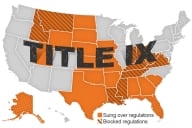You have /5 articles left.
Sign up for a free account or log in.

After opening dozens of investigations into alleged antisemitic or Islamophobic harassment, the department is starting to wrap up those inquiries.
Caroline Brehman/CQ-Roll Call Inc./Getty Images
When a student at Lafayette College held up a poster that included the phrase “from the river to the sea” at a protest last October, officials who’d been monitoring the demonstration reacted quickly.
They met to “discuss the hurtful nature of the poster” and identify the student, who was spoken with that same day about the use of the phrase and why many consider it antisemitic, according to federal officials who subsequently investigated whether Lafayette, a private liberal arts college in Pennsylvania, failed to properly respond to harassment of Jewish students. The student who held the poster agreed a few days later to not use the phrase again. The president of the college addressed the use of the phrase in a campuswide email sent the day of the protest, calling it “an incident of deep concern.”
But when a student anonymously complained a day after the protest about another student’s Instagram post that included the same phrase, officials responded that the post fell within the student’s free speech rights and didn’t constitute a direct threat. No further action was taken.
The October protest and social media complaint were among the antisemitism complaints that Lafayette officials received last fall. They became the center of a Title VI investigation that concluded Friday, when the college reached an agreement with the Education Department’s Office for Civil Rights to resolve the inquiry. It’s the third resolution the department has announced in the dozens of civil rights investigations OCR has undertaken since the Hamas attack on Israel Oct. 7.
In other complaints involving social media, officials took the same approach as with the “from the river to the sea” post, OCR said, although they offered support to the complainants. The college chaplain, for instance, offered to mediate a conversation between a student who complained about an offensive post that depicted an Israel Defense Forces soldier as the equivalent of a Nazi soldier and the student who posted it.
Ultimately, Lafayette officials’ “inconsistent” responses to complaints of alleged harassment on social media fell short of Lafayette’s obligations under federal civil rights law, OCR said. It pointed specifically to the divergent approaches to the complaints stemming from the use of “from the river to the sea” on campus and on social media.
OCR’s findings offer some clarity for other institutions grappling with what they’re obliged to do when social media and off-campus conduct prompt civil rights complaints. Just as with allegations of on-campus harassment, OCR made clear, colleges are required to investigate and determine whether that conduct creates or contributes to a hostile environment.
First Amendment experts are concerned that OCR’s findings could lead campuses to crack down on political speech. “The implication here that the institution didn’t do enough to respond to constitutionally protected expression, and therefore could be violating Title VI, is a field day to would-be censors,” said Tyler Coward, lead counselor for government affairs at the Foundation for Individual Rights and Expression, a free speech and civil liberties advocacy organization. “The result of this will be many institutions choosing to censor speech on politically hot topics instead of letting universities really be these true marketplaces.”
OCR says that its resolution agreements don’t set precedents, only its determinations on individual cases. But its findings do shed some light on how colleges can comply with Title VI of the Civil Rights Act of 1964—and, in this case, how they’re expected to balance students’ First Amendment rights against the rights of others who say their speech is harmful.
Under Title VI, colleges and universities that receive federal money must protect students from discrimination based on race, color or national origin. The department has said Title VI covers discrimination based on shared ancestry, which includes Jewish students, Muslim students and members of other ethnic or religious groups. When a university receives a report of prohibited harassment or discrimination that occurs on or off campus, it is obligated to respond and investigate, determine whether a hostile environment exists, and then remedy the situation to prevent it from persisting.
What Lafayette College first failed to do, the agency said, was properly assess whether the social media posts that spawned complaints were contributing to a hostile environment for Jewish students.
For example, one student complained about an Instagram post that compared a Palestinian dying with Jesus dying and said “Same Picture, Same Land, Same Perpetrator,” according to the letter. Lafayette’s Title IX coordinator said that the post was antisemitic but not a direct threat or targeted at a specific individual. The student who complained was told that the post was a “free speech issue” and offered supportive services.
But college officials weren’t always so hands-off. After an anonymous complaint was made about an Instagram post from Lafayette’s Middle Eastern Student Association, the dean of students wondered if the post crossed “into a type of discriminatory harassment coming from an official group,” according to the OCR letter. The post stated, “How do you not feel embarrassed and ashamed as an American Jew posting about how ‘scared’ you are between posts of you out to dinner and partying with friends? As Palestinians dig through rubble to find pieces of their slaughtered children.”
The vice president for student life responded to the dean that the post was problematic because it called out a particular group. Several college officials subsequently met with the student group’s executive board to discuss the post and how it made “some College students feel uncomfortable and unwelcome.”
Lafayette's responses weren’t designed to remedy a hostile environment, the OCR said: “The college appears generally not to have addressed allegations of harassment occurring on social media unless the college considered the harassment to constitute a direct threat.” That meant Lafayette was “not recognizing its Title VI obligation—which is not limited to conduct that occurs on campus or outside social media—to redress a hostile environment.”
Dissecting the Free Speech Implications
As colleges have dealt with the protests and an increase in reports of antisemitic and Islamophobic harassment, officials have struggled with how to comply with the law without infringing on students’ free speech rights and have sought greater clarity about what exactly is considered a Title VI violation.
The First Amendment considerations can be different for public universities and private colleges like Lafayette; the latter have more latitude in regulating speech. While public institutions have a legal obligation to address speech that “contributes to a hostile environment,” they “may be constrained” in how they can deal with harassing speech, OCR said in recent guidance about how to respond to Title VI allegations.
Eugene Volokh, a law professor at the University of California, Los Angeles, who teaches about the First Amendment, said the Lafayette agreement shows the Education Department thinks colleges are obligated to suppress certain kinds of speech or face the potential loss of federal funds. The implications for student speech are concerning, he said. If universities are required to take effective action to end harassment, he argues, the only truly effective way is to threaten students with discipline or expulsion for offensive social media posts.
“The Department of Education’s view is that universities have to suppress this kind of speech,” he said, “and I think that violates the First Amendment.”
Volokh acknowledged that the resolution doesn’t specifically spell out what actions Lafayette—or any college—is supposed to take to deal with harassment, meaning that colleges could find ways to avoid restricting student speech and not run afoul of the OCR. But what would happen, he asked, if the student who held up a poster with “from the river to the sea” decided to keep using the phrase?
“The university would have an obligation to take offensive action to stop that,” he said. “The only way it can do that is by threatening to punish him, not just to talk to him. … I think the logic of what the Department of Education is saying is that you have to do whatever it takes to make it stop.”
OCR said in recent guidance that its Title VI interpretation doesn’t require a college or university to infringe on a student’s First Amendment rights. Colleges can fulfill their legal obligations by communicating their opposition to “stereotypical, derogatory opinions”; providing counseling to students affected by the harassment; or taking steps to create a “welcoming and respectful” campus.
The agency noted that Lafayette did take some action to address a possible hostile environment—just not enough. The college issued a campuswide message about how “the war in the Middle East is causing antisemitism and Islamophobia to rise,” for one, while increasing the police presence around both the campus Hillel center and the Muslim prayer room and meeting with campus groups about how to “provide support to communities with religious differences.”
Under the agreement, the college agreed to step up antidiscrimination training, review its response to all reports of shared ancestry discrimination and harassment in the 2023–24 academic year, and provide any such complaints to OCR for the next two years, among other steps.
“We take these matters most seriously and, consistent with our close partnership with OCR during its investigation, will follow through fully on these obligations,” Lafayette president Nicole Hurd said in a statement Friday. “Doing so is consistent with the College’s firm stance against antisemitism, Islamophobia, and hate speech of any kind, and with our determination to remain vigilant in protecting the safety and well-being of all our students, faculty, and staff.”








